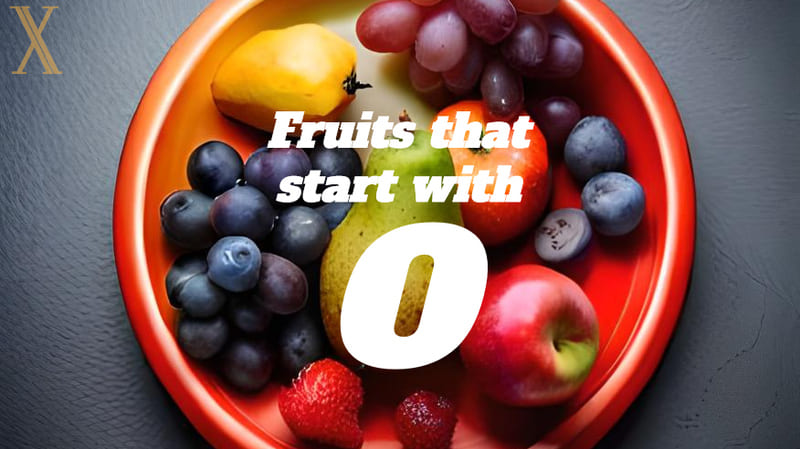
If you want to expand your fruit horizons, fruits that start with M are a great place to start. There’s a wide variety, from tropical fruits like Mamey Apple and Mamey Sapote to more familiar ones like Mandarin and Mango. In addition, some fruits have been linked to several health benefits, including improved heart health, lower risk of chronic diseases, and more robust immune systems.
This article will explore some of the most delicious and nutritious fruits that start with M, including their taste, nutritional value, and culinary uses.
Check the table of contents if you want to see the entire all the fruits with M.
Macadamia Nuts
Macadamia nuts are native to Australia but are now widely cultivated in Hawaii and other parts of the world. They are highly nutritious and have a creamy, buttery flavor with a slightly sweet taste. They are commonly used in baking and cooking but can also be eaten raw as a snack. Macadamia nuts are a good source of healthy monounsaturated fats, vitamins, and minerals. They are also high in fiber and antioxidants and, therefore, linked to various health benefits, including improved heart health and lower risk of chronic diseases.
Macoun Apple
The Macoun apple is a wide variety of apples first developed in the United States. It is a cross between the ‘McIntosh’ and ‘Jersey Black,’ resulting in a medium-sized apple with red and green skin that is crisp and juicy with a sweet-tart flavor. The Macoun apple is widely used in baking and cooking but can also be eaten raw as a snack. It is a good source of dietary fiber and vitamin C, which can help support a healthy immune system.
Madras Thorn
Pithecellobium dulce, commonly known as Manila tamarind, Madras thorn, monkeypod tree, or camachile, is a tropical fruit tree native to India but is now widely cultivated in other parts of the world. The fruit is small, yellow, and pod-like, with a tangy and sour taste similar to tamarind. It is commonly used in cooking but can also be eaten raw as a snack. Madras Thorn is a good source of dietary fiber, vitamins, and minerals, including vitamin C, potassium, and calcium.
Mamey Apple
Mammea americana, commonly known as mammee, mammee apple, mamey, mamey apple, Santo Domingo apricot, or tropical apricot, is a tropical fruit native to the West Indies and Central America. The fruit is roughly the size of a large apple and has tough, brownish-red skin. Inside, the fruit has a creamy, salmon-colored flesh that is very sweet and aromatic. The texture of the meat is similar to that of an avocado or baked sweet potato. Mamey apples are often eaten fresh or used to make smoothies, ice cream, and other desserts.
Mamey Sapote
Pouteria sapota, commonly known as Mamey Sapote, is a fruit native to Mexico, Central America, and parts of South America. The fruit is about the size of a small football and has tough, brownish-red skin. The fruit’s flesh is bright orange and has a creamy texture similar to an avocado’s. Mamey Sapote has a sweet, tropical flavor often compared to a combination of sweet potato, pumpkin, and apricot. The fruit is usually eaten fresh or used in desserts, such as pies, ice cream, and smoothies.
Mamoncillo
Melicoccus bijugatus, known as Mamoncillo, Quenepa, or Spanish Lime, is a tropical fruit native to Central and South America. The fruit is small, about the size of a cherry, and has a thin, greenish-yellow skin. Inside, the fruit has a soft, white pulp surrounding a large seed. Mamoncillo has a sweet, tangy flavor similar to a combination of lime, lychee, and grapefruit. The fruit is often eaten fresh and is a popular snack in many Latin American countries.
Mandarin
Citrus reticulata, also known as mandarin or mandarine, is a small citrus tree fruit. The fruit is small and round, with a thin, easy-to-peel skin. The fruit is divided into juicy and sweet segments with few seeds. Mandarins come in various types, including Satsumas, Clementines, and Tangerines. The fruit is often eaten fresh and is a popular snack worldwide. In addition, it is common to use mandarin juice in cocktails and other beverages.
Mango
Mango is an edible stone fruit produced by the tropical tree Mangifera indica. It is probably native to Myanmar, Bangladesh, and northeastern India. Still, it is now grown in many tropical and subtropical regions worldwide. The fruit is large and oval-shaped, with yellow-orange skin that sometimes has a red blush. Inside, the fruit has a juicy, sweet, and aromatic flesh, often described as a combination of peach, pineapple, and apricot. You can eat mangoes fresh or use them in various dishes, including salads, smoothies, and desserts.
Mangosteen
Garcinia mangostana, or simply Mangosteen, is a tropical fruit native to Southeast Asia. It has a tough purple outer shell with soft, juicy white flesh with a sweet, tangy, and slightly acidic flavor. Mangosteen is highly nutritious and contains many vitamins, minerals, and antioxidants. It has been used for centuries in traditional medicine to treat various ailments such as diarrhea, skin infections, and inflammation. Mangosteen is commonly eaten fresh, but you can make juice, jam, or add it to desserts.
Maqui
Aristotelia chilensis, known as maqui or Chilean wineberry, is a small, dark purple berry native to South America. It has a sweet and slightly tart flavor and is rich in antioxidants, anthocyanins, and polyphenols. Maqui has been used in traditional medicine to treat inflammation, diabetes, and high cholesterol. It is commonly eaten fresh, but also as an ingredient to make juice and jams.
Marionberry
Rubus L. subgenus Rubus, marionberry is a cultivar of blackberry developed by the USDA ARS breeding program in cooperation with Oregon State University. It is a cross between the ‘Chehalem’ and ‘Olallie’ varieties. It is the most common form of blackberry cultivated, accounting for over half of all blackberries produced in Oregon. The berry has a somewhat tart flavor, is relatively earthy with traces of sweetness, and is more significant, sweeter, and juicier than the ‘Evergreen’ blackberry. The marionberry dominates current blackberry production, with Oregon producing between 28 million and 33 million pounds annually. The berry was released in 1956 under the name Marion, based on the county where it was tested extensively. There is also a hybrid variety with boysenberry in Australia called Silvanberry.
Marsh Pink Grapefruit
The Marsh Pink grapefruit is a variety of grapefruit whose beginnings date back to Florida in the early 1900s. It is a large, juicy fruit with a sweet and slightly tangy flavor. The flesh is pink in color and has a distinctive grapefruit aroma.
Masak Hijau
Musa acuminata, known as The Masak, Lacatan, Monte Cristo, Giant Fig, Bungulan, and Mestiça, is a type of banana native to Indonesia. It is a small to medium-sized banana with bright green skin and a sweet flavor. The flesh is creamy and has a slightly sticky texture. The Masak Hijau banana is often used in Indonesian cuisine and is a popular snack.
McIntosh Apple
Malus domestica, typically called McIntosh Apple or Mac, is a type of apple that originated in Canada in the early 19th century. It is known for its red and green skin with a white, juicy flesh that has a sweet and tangy flavor. The texture of the McIntosh Apple is firm, but it becomes soft when cooked, making it perfect for pies, applesauce, and other baked goods. McIntosh Apples are harvested in late September (considered an early apple variety). This fruit is commonly used in cooking and baking due to its excellent flavor and texture.
Medlar
Mespilus germanica, also known as medlar, is a fruit tree in the rose family Rosaceae. Its fruit has been cultivated since Roman times and is usually available in winter. The medlar flowers are very late and produce flattened, reddish-brown, hairy fruits with juicy flesh. The fruit’s diameter is between 3 and 8 cm in cultivated forms. The wood of the medlar is fine-textured and very hard, and its leaves are dark green and elliptic.
Melinjo
Gnetum gnemon, which common names include gnetum, joint fir, melinjo, belinjo, bago, and tulip, is a small fruit native to Southeast Asia. The fruit is oval-shaped and has a thin, greenish-brown skin with white, crunchy flesh inside. Melinjo fruit is often used in Indonesian cuisine, typically in boiled or roasted formats, and then eaten as a snack or added to various dishes. The fruit is high in protein and a good source of vitamins and minerals.
Melon
Cucumis melo, also known as melon, is a type of fruit that belongs to the gourd family, including cucumbers, pumpkins, and squash. Melons come in various shapes and sizes and have juicy, sweet flesh often eaten as a dessert or used in salads. In addition, they are low in calories and high in vitamins A and C. Some popular varieties of melon include cantaloupe, honeydew, and watermelon. Melons are harvested during the summer months and enjoyed worldwide for their refreshing taste and nutritional benefits.
Melon pear
Solanum muricatum, also known as Melon pear or Pepino Dulce (sweet cucumber), is a small, oval-shaped fruit with smooth, waxy skin that varies in color from yellow to purple with purple stripes. It is native to South America, but people grow it in many parts of the world nowadays, including the United States, New Zealand, and Europe. The inside of the fruit is white or pale yellow with a texture similar to melon but with a sweeter, milder flavor. The fruit can be eaten raw or used in salads, desserts, or smoothies. It is rich in vitamins C and A, potassium, and dietary fiber. It is part of traditional medicine for its diuretic and digestive properties.
Mexican Limes
(Citrus × aurantiifolia), known as Mexican limes, also known as Key limes, are small, round citrus fruits that are native to Southeast Asia but are now widely cultivated in Mexico and other parts of the world. The fruit is typically green when unripe and turns yellow when fully ripe, with a thin, smooth skin and a juicy, acidic pulp. Mexican limes are commonly used to make lime juice for cooking, baking, cocktails, and in marinades, dressings, and sauces. People use these limes in traditional medicine for their antibacterial and anti-inflammatory properties, but they are also valuable for being a good source of vitamin C, calcium, and potassium.
Meyer Lemon
Citrus × meyeri, the Meyer lemon is a hybrid citrus fruit with the belief of being a cross between a citron and a mandarin/pomelo. Its name belongs to Frank Meyer, an agricultural explorer who discovered the fruit in China in the early 20th century. The fruit is small to medium, with a thin, smooth skin that ranges from yellow to orange. The pulp is juicy and acidic but sweeter than a traditional lemon, with a floral aroma and a hint of mandarin or orange flavor. As a result, Meyer lemons are super helpful in bakery and cocktails. In addition, they are a good source of vitamin C, potassium, and dietary fiber.
Miracle Fruit
Synsepalum dulcificum, also known as miracle fruit, miracle berry, miraculous berry, or sweet berry, is a small red fruit native to West Africa. This fruit is renowned for its unusual ability to make sour foods taste sweet. The flesh of the miracle fruit contains a protein called miraculin, which binds to taste buds and alters how we perceive taste. After consuming the fruit, sour foods like lemons, limes, and grapefruit taste sweet for up to an hour. Miracle fruit is low in calories and contains antioxidants that may have health benefits. As a result, it is a sugar substitute for people with diabetes or those on a low-sugar diet. The ones who eat it typically enjoy it fresh. Still, it can be freeze-dried or made into tablets for easier consumption.
Monkfruit
Siraitia grosvenorii, also known as monkfruit or luohan guo, is a small, black-green fruit native to southern China. The fruit is well-known for its intense sweetness, which comes from natural compounds called mogrosides found in the fruit’s flesh. Monk fruit is often used as a sugar substitute in food and beverages, particularly in products marketed toward people with diabetes or those following a low-sugar diet. Unlike sugar, monk fruit is shallow in calories and does not impact blood sugar levels. You can eat this fruit fresh, but it is typically dried and processed into a powder or liquid form for easier use in cooking and baking.
Monster fruit
Monstera deliciosa, also known as the Swiss cheese plant, delicious monster, fruit salad plant, fruit salad tree, ceriman, monster fruit, monsterio delicio, or monstereo, is a popular houseplant native to Central and South America. The plant produces an edible fruit that is similar in appearance to a green ear of corn. The fruit is not commonly consumed as it takes up to a year to ripen and is only edible when fully ripe. The fruit’s flesh is sweet and has a tropical flavor, similar to pineapple or banana. In some parts of the world, the fruit is used to flavor drinks and desserts. While the flesh is edible, the rest of the plant, including the leaves and stems, are toxic to humans and pets.
Mora De Castilla
Rubus glaucus, commonly known as Mora de Castilla or Andean raspberry, is a type of blackberry native to Mexico and Central America. The fruit is round and dark purple, with a sweet, tart flavor. Mora de Castilla is rich in antioxidants, fiber, and vitamin C. The fruit is commonly eaten fresh but can also be used to make jams, jellies, and desserts. In traditional medicine, the mora de Castilla plant leaves are used to treat diarrhea. In contrast, the roots are used to treat fevers and respiratory ailments. The fruit has a short shelf life, so consuming it within a few days of harvesting is better.
Moringa
Moringa oleifera, commonly known as moringa, drumstick tree, or horseradish tree, is a fast-growing tree of the family Moringaceae, native to the Indian subcontinent, widely cultivated for its young seed pods and leaves, used as vegetables and for traditional herbal medicine. It is also used for water purification. The tree is fast-growing, deciduous, and can reach a height of 10-12 meters. The flowers are fragrant and hermaphroditic. The fruit is a hanging, three-sided brown capsule with dark brown, globular seeds with a diameter of around 1 cm. The moringa tree is grown mainly in semiarid, tropical, and subtropical areas. However, it is particularly suitable for dry regions, as it can be developed using rainwater without expensive irrigation techniques.
Mountain papaya
Vasconcellea pubescens, also known as mountain pawpaw, papayuelo, chamburo, or mountain papaya, is a tropical fruit tree native to the Andean region of South America. The fruit is similar in appearance to papaya but smaller and with a sweeter, more intense flavor. The flesh is orange and juicy and contains numerous tiny, black seeds. Mountain papaya is often consumed raw but can also be used in desserts, jams, and other culinary applications. In traditional medicine, people use the tree for its leaves and bark.
Mountain soursop
Annona montana, the mountain soursop, is a tropical fruit tree native to Central and South America. The fruit is similar in appearance to soursop but smaller and with a sweeter, more delicate flavor. The flesh is white and creamy, with numerous tiny, black seeds. Mountain soursop usually is eaten fresh.
Mulberries
Morus, a genus of flowering plants in the family Moraceae, consists of diverse species of deciduous trees commonly known as mulberries. Their leaves are simple and arranged alternately, often with lobes and serrations, particularly on young trees. The fruit is a multiple that initially appears white, green, or pale yellow. It then changes color from pink to red as it ripens, ultimately turning dark purple or black with a sweet flavor. Mulberry trees may be monoecious or dioecious.
Muscadine
Vitis rotundifolia, or muscadine, is a grape native to the southeastern United States. The fruit is typically dark purple or black and has a thick skin that is often tough and bitter. The inside of the fruit is soft and juicy with a sweet flavor that people describe as having a musky, earthy taste. Muscadines are high in antioxidants, fiber, and other nutrients with several health benefits, such as reducing inflammation and protecting against certain types of cancer. Locals use these fruits in jams, jellies, and wine production.
Myrtles
Myrtus communis, commonly known as common myrtle or true myrtle, is a fragrant evergreen shrub or small tree that grows up to 5 meters tall. It is native to southern Europe, North Africa, Western Asia, Macaronesia, and the Indian Subcontinent. The plant has historical and symbolic significance in ancient cultures, including Greco-Roman mythology and Jewish traditions, and was later associated with love during the Renaissance. Its leaves have a fragrant essential oil, and its flowers have five petals and many stamens. The plant’s berries are edible and are used to make Mirto liqueur. The plant and its subspecies have won the Royal Horticultural Society’s Award of Garden Merit and prefer a sheltered position in full sun.
Mysore Raspberry
Rubus niveus known as Mysore raspberry, Ceylon raspberry, hill raspberry, is a type of raspberry native to the Indian subcontinent and Southeast Asia. The fruit is small, round, and bright red, ripening black with a sweet and slightly tart flavor. Mysore raspberries are high in vitamin C and antioxidants, making them a nutritious addition to a healthy diet. They are often eaten fresh as a snack or used in jams and desserts. However, the plant is considered invasive in some areas and can nuisance to farmers and gardeners.
-

The A-List of Fruits: A Journey Through Fruits that Start with A
-

Fruits that Start with B: A Guide to the Best of the Bunch
-

Discover the Sweet World of Fruits That Start with C
-

Fruits That Start with D: Discovering Exotic Flavors
-

15 Fruits That Start With E: A Delicious Guide
-

23 Fruits that Start with F: A Guide to Nutritious Options
-

Fruit Alphabet: Discovering Fruits that Start with G
-

Fruits that start with H: From Habanero Pepper to …
-

22 Fruits That Start With I: Nutritious and Medicinal Treasures
-

25+ Fruits that Start with J: A comprehensive list
-

35+ Fruits that Start With K (with a short description)
-

Fruits that Start with L: From Lablab to Lychee
-

The Mighty M’s: A Guide to Fruits That Start with M
-

Fruitful N: Discovering Exotic Fruits That Start With N
-

The Encyclopedia for the Fruits That Start with O
